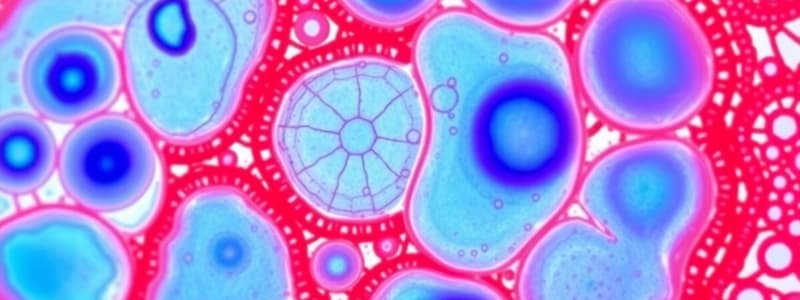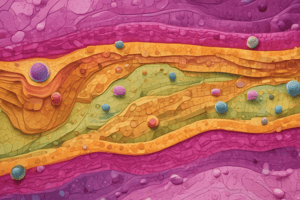Podcast
Questions and Answers
What is the name given to the tissue that covers a body surface or lines a body cavity?
What is the name given to the tissue that covers a body surface or lines a body cavity?
- Nervous tissue
- Muscle tissue
- Connective tissue
- Epithelial tissue (correct)
Which of the following is NOT a feature used to classify epithelia?
Which of the following is NOT a feature used to classify epithelia?
- Cell shape
- Presence of cilia
- Number of cell layers
- Cell size (correct)
What type of epithelium is characterized by multiple layers of cells that can change shape?
What type of epithelium is characterized by multiple layers of cells that can change shape?
- Pseudostratified epithelium
- Transitional epithelium (correct)
- Simple epithelium
- Stratified epithelium
What is the primary function of cilia found on the apical surface of epithelial cells?
What is the primary function of cilia found on the apical surface of epithelial cells?
Which of the following is NOT a specialized form of epithelium?
Which of the following is NOT a specialized form of epithelium?
What two components make up the basement membrane that separates an epithelium from the underlying connective tissue?
What two components make up the basement membrane that separates an epithelium from the underlying connective tissue?
Which type of epithelial tissue lines the interior of blood vessels?
Which type of epithelial tissue lines the interior of blood vessels?
What is the primary function of the simple squamous epithelium found in the alveoli of the lungs?
What is the primary function of the simple squamous epithelium found in the alveoli of the lungs?
Which type of epithelial tissue is responsible for moving particles across its surface and can be found in airways?
Which type of epithelial tissue is responsible for moving particles across its surface and can be found in airways?
What are the five functions of epithelial tissue?
What are the five functions of epithelial tissue?
Which type of epithelium is found lining the oral cavity?
Which type of epithelium is found lining the oral cavity?
Which gland secretes hormones directly into the bloodstream?
Which gland secretes hormones directly into the bloodstream?
What type of epithelium is primarily involved in secretion and absorption within salivary glands?
What type of epithelium is primarily involved in secretion and absorption within salivary glands?
What characteristic defines epithelial tissue's polarity?
What characteristic defines epithelial tissue's polarity?
Which epithelium provides protection from friction and abrasion in the tongue area?
Which epithelium provides protection from friction and abrasion in the tongue area?
Which type of epithelial tissue is characterized by its ability to stretch and line the urinary bladder?
Which type of epithelial tissue is characterized by its ability to stretch and line the urinary bladder?
Flashcards
Pseudostratified Ciliated Columnar Epithelium
Pseudostratified Ciliated Columnar Epithelium
A type of epithelial tissue specialized for moving particles across its surface. Found in airways and the lining of the oviduct.
Functions of Epithelium
Functions of Epithelium
Five key functions of epithelial tissues are protection, absorption, secretion, excretion, and sensation.
Characteristics of Epithelium
Characteristics of Epithelium
Five key characteristics of epithelial tissues are cellularity, polarity, supported by connective tissues, avascular, and regeneration.
Non-Keratinized Stratified Squamous Epithelium
Non-Keratinized Stratified Squamous Epithelium
Signup and view all the flashcards
Keratinized Stratified Squamous Epithelium
Keratinized Stratified Squamous Epithelium
Signup and view all the flashcards
Simple Cuboidal Epithelium
Simple Cuboidal Epithelium
Signup and view all the flashcards
Mucous Membrane (Oral Cavity)
Mucous Membrane (Oral Cavity)
Signup and view all the flashcards
Endocrine Glands
Endocrine Glands
Signup and view all the flashcards
Tissue
Tissue
Signup and view all the flashcards
Organ
Organ
Signup and view all the flashcards
Epithelial Tissue
Epithelial Tissue
Signup and view all the flashcards
How to classify epithelial tissue: Number of Cell Layers
How to classify epithelial tissue: Number of Cell Layers
Signup and view all the flashcards
How to classify Epithelial Tissue: Cell Shape
How to classify Epithelial Tissue: Cell Shape
Signup and view all the flashcards
Transitional Epithelium
Transitional Epithelium
Signup and view all the flashcards
Cilia on Epithelial Cells
Cilia on Epithelial Cells
Signup and view all the flashcards
Basement Membrane
Basement Membrane
Signup and view all the flashcards
Study Notes
Epithelial Tissue
- Epithelial tissue forms a protective barrier and is involved in absorption, secretion, and sensation
- It lines organs, glands, and the body surface
- It's classified by the number of cell layers: single (simple), multiple (stratified), or appearing multiple but single (pseudostratified)
- Cell shape also categorizes epithelium: squamous (flat and thin), cuboidal (cube-like), and columnar (rectangular, height > width)
- Transitional epithelium: cells change shape, flattened when not stretched, pear-shaped when stretched
- Specialized functions include: glandular epithelium (secretion) and ciliated epithelium (movement of particles/fluids)
Epithelial Cell Shapes
- Squamous cells: flat and thin
- Cuboidal cells: cube-shaped
- Columnar cells: rectangular, height greater than width
Epithelial Cell Specializations
- Cilia: hair-like structures projecting from the apical surface, involved in moving substances (e.g., mucus in respiratory tracts)
- Specialized glands: endocrine (release hormones directly into bloodstream), exocrine (secrete substances into ducts)
- Example of endocrine: thyroid gland secretes thyroxine/triiodothyronine
- Example of exocrine: salivary glands secrete saliva
Epithelial Tissue Components
- Basement membrane: separates epithelium from connective tissue layers
- Basal lamina: contains protein, anchors epithelial cells
- Reticular lamina: contains collagen fibers, connect to connective tissue
Epithelial Tissue Function
- Protection
- Absorption
- Secretion
- Excretion
- Sensation
Epithelial Tissue Characteristics
- Cellularity: composed of tightly packed cells
- Polarity: apical (free) and basal (attached) surfaces
- Supported by connective tissue
- Avascular: lacks blood vessels, receives nutrients via diffusion from connective tissue
- Regeneration: readily replaces damaged cells
Sample Epithelial Tissue Examples
- Oral cavity: non-keratinized stratified squamous epithelium
- Salivary glands: simple cuboidal epithelium
- Blood vessels: simple squamous epithelium
- Airways/oviducts: pseudostratified ciliated columnar epithelium
- Skin: stratified squamous epithelium
Studying That Suits You
Use AI to generate personalized quizzes and flashcards to suit your learning preferences.




